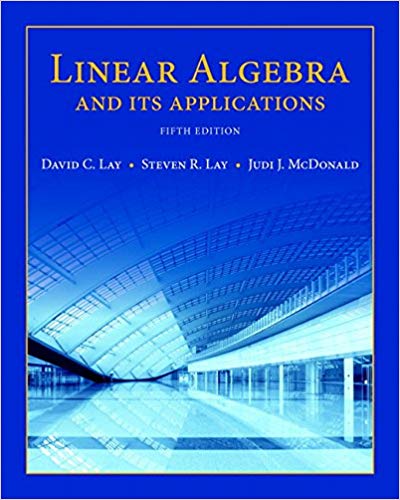
Linear Algebra and Its Applications, 5th Edition
Authors: David C. Lay, Steven R. Lay, Judi J. McDonald
ISBN-13: 978-0321982384
We have solutions for your book!
See our solution for Question 1E from Chapter 6.3 from Lay's Linear Algebra and Its Applications, 5th Edition.
Problem 1E
Chapter:
Problem:
Write x as the sum of two vectors, one in...
Step-by-Step Solution
Step 1
Given Vectors:\[{{\bf{u}}_1} = \left[ {\begin{array}{*{20}{c}}0\\1\\{ - 4}\\{ - 1}\end{array}} \right],{{\bf{u}}_2} = \left[ {\begin{array}{*{20}{c}}3\\5\\1\\1\end{array}} \right],{{\bf{u}}_3} = \left[ {\begin{array}{*{20}{c}}1\\0\\1\\{ - 4}\end{array}} \right]{\rm{ }}\,\,{\rm{and}}\,\,{\rm{ }}{{\bf{u}}_4} = \left[ {\begin{array}{*{20}{c}}5\\{ - 3}\\{ - 1}\\1\end{array}} \right]{\rm{ }}\,{\rm{and}}\,\,{\rm{ }}{\bf{x}} = \left[ {\begin{array}{*{20}{c}}{10}\\{ - 8}\\2\\0\end{array}} \right]\]We have to write vector, $x$ as the sum of two vectors, one in ${\rm{Span}}\left\{ {{u_1},{u_2},{u_3}} \right\}$ and the other in ${\rm{Span}}\left\{ {{u_4}} \right\}$
Step 2: Orthogonal projection of $x$
\[\begin{array}{l}{\bf{\mathord{\buildrel{\lower3pt\hbox{$\scriptscriptstyle\frown$}} \over x} }} = \dfrac{{{\bf{x}}\cdot{{\bf{u}}_1}}}{{{{\bf{u}}_1}\cdot{{\bf{u}}_1}}}{{\bf{u}}_1} + \dfrac{{{\bf{x}}\cdot{{\bf{u}}_2}}}{{{{\bf{u}}_2}\cdot{{\bf{u}}_2}}}{{\bf{u}}_2} + \dfrac{{{\bf{x}}\cdot{{\bf{u}}_3}}}{{{{\bf{u}}_3}\cdot{{\bf{u}}_3}}}{{\bf{u}}_3}\\ = \dfrac{{\left[ {\begin{array}{*{20}{c}}{10}&{ - 8}&2&0\end{array}} \right]\left[ {\begin{array}{*{20}{c}}0\\1\\{ - 4}\\{ - 1}\end{array}} \right]}}{{\left[ {\begin{array}{*{20}{c}}0&1&{ - 4}&{ - 1}\end{array}} \right]\left[ {\begin{array}{*{20}{c}}0\\1\\{ - 4}\\{ - 1}\end{array}} \right]}}{{\bf{u}}_1} + \dfrac{{\left[ {\begin{array}{*{20}{c}}{10}&{ - 8}&2&0\end{array}} \right]\left[ {\begin{array}{*{20}{c}}3\\5\\1\\1\end{array}} \right]}}{{\left[ {\begin{array}{*{20}{c}}3&5&1&1\end{array}} \right]\left[ {\begin{array}{*{20}{c}}3\\5\\1\\1\end{array}} \right]}}{{\bf{u}}_2} + \dfrac{{\left[ {\begin{array}{*{20}{c}}{10}&{ - 8}&2&0\end{array}} \right]\left[ {\begin{array}{*{20}{c}}1\\0\\1\\{ - 4}\end{array}} \right]}}{{\left[ {\begin{array}{*{20}{c}}1&0&1&{ - 4}\end{array}} \right]\left[ {\begin{array}{*{20}{c}}1\\0\\1\\{ - 4}\end{array}} \right]}}{{\bf{u}}_3}\\ = \dfrac{{\left( {0 - 8 - 8 + 0} \right)}}{{0 + 1 + 16 + 1}}{{\bf{u}}_1} + \dfrac{{\left( {30 - 40 + 2 + 0} \right)}}{{9 + 25 + 1 + 1}}{{\bf{u}}_2} + \dfrac{{\left( {10 + 0 + 2 + 0} \right)}}{{1 + 0 + 1 + 16}}{{\bf{u}}_3}\\ = - \dfrac{8}{9}\left[ {\begin{array}{*{20}{c}}0\\1\\{ - 4}\\{ - 1}\end{array}} \right] - \dfrac{2}{9}\left[ {\begin{array}{*{20}{l}}3\\5\\1\\1\end{array}} \right] + \dfrac{6}{9}\left[ {\begin{array}{*{20}{c}}1\\0\\1\\{ - 4}\end{array}} \right]\\ = \left[ {\begin{array}{*{20}{c}}0\\{ - 2}\\4\\{ - 2}\end{array}} \right]\end{array}\]
Step 3: The orthogonal component
\[\begin{array}{l}{\bf{z}} = {\bf{x}} - {\bf{\mathord{\buildrel{\lower3pt\hbox{$\scriptscriptstyle\frown$}} \over x} }}\\ = \left[ {\begin{array}{*{20}{c}}{10}\\{ - 8}\\2\\0\end{array}} \right] - \left[ {\begin{array}{*{20}{c}}0\\{ - 2}\\4\\{ - 2}\end{array}} \right]\\ = \left[ {\begin{array}{*{20}{c}}{10}\\{ - 6}\\{ - 2}\\2\end{array}} \right]\end{array}\]
ANSWERS
The x as sum of given vectors \[{\bf{x}} = \left[ {\begin{array}{*{20}{c}}0\\{ - 2}\\4\\{ - 2}\end{array}} \right] + \left[ {\begin{array}{*{20}{c}}{10}\\{ - 6}\\{ - 2}\\2\end{array}} \right]\]
Given Vectors:\[{{\bf{u}}_1} = \left[ {\begin{array}{*{20}{c}}0\\1\\{ - 4}\\{ - 1}\end{array}} \right],{{\bf{u}}_2} = \left[ {\begin{array}{*{20}{c}}3\\5\\1\\1\end{array}} \right],{{\bf{u}}_3} = \left[ {\begin{array}{*{20}{c}}1\\0\\1\\{ - 4}\end{array}} \right]{\rm{ }}\,\,{\rm{and}}\,\,{\rm{ }}{{\bf{u}}_4} = \left[ {\begin{array}{*{20}{c}}5\\{ - 3}\\{ - 1}\\1\end{array}} \right]{\rm{ }}\,{\rm{and}}\,\,{\rm{ }}{\bf{x}} = \left[ {\begin{array}{*{20}{c}}{10}\\{ - 8}\\2\\0\end{array}} \right]\]We have to write vector, $x$ as the sum of two vectors, one in ${\rm{Span}}\left\{ {{u_1},{u_2},{u_3}} \right\}$ and the other in ${\rm{Span}}\left\{ {{u_4}} \right\}$
Step 2: Orthogonal projection of $x$
\[\begin{array}{l}{\bf{\mathord{\buildrel{\lower3pt\hbox{$\scriptscriptstyle\frown$}} \over x} }} = \dfrac{{{\bf{x}}\cdot{{\bf{u}}_1}}}{{{{\bf{u}}_1}\cdot{{\bf{u}}_1}}}{{\bf{u}}_1} + \dfrac{{{\bf{x}}\cdot{{\bf{u}}_2}}}{{{{\bf{u}}_2}\cdot{{\bf{u}}_2}}}{{\bf{u}}_2} + \dfrac{{{\bf{x}}\cdot{{\bf{u}}_3}}}{{{{\bf{u}}_3}\cdot{{\bf{u}}_3}}}{{\bf{u}}_3}\\ = \dfrac{{\left[ {\begin{array}{*{20}{c}}{10}&{ - 8}&2&0\end{array}} \right]\left[ {\begin{array}{*{20}{c}}0\\1\\{ - 4}\\{ - 1}\end{array}} \right]}}{{\left[ {\begin{array}{*{20}{c}}0&1&{ - 4}&{ - 1}\end{array}} \right]\left[ {\begin{array}{*{20}{c}}0\\1\\{ - 4}\\{ - 1}\end{array}} \right]}}{{\bf{u}}_1} + \dfrac{{\left[ {\begin{array}{*{20}{c}}{10}&{ - 8}&2&0\end{array}} \right]\left[ {\begin{array}{*{20}{c}}3\\5\\1\\1\end{array}} \right]}}{{\left[ {\begin{array}{*{20}{c}}3&5&1&1\end{array}} \right]\left[ {\begin{array}{*{20}{c}}3\\5\\1\\1\end{array}} \right]}}{{\bf{u}}_2} + \dfrac{{\left[ {\begin{array}{*{20}{c}}{10}&{ - 8}&2&0\end{array}} \right]\left[ {\begin{array}{*{20}{c}}1\\0\\1\\{ - 4}\end{array}} \right]}}{{\left[ {\begin{array}{*{20}{c}}1&0&1&{ - 4}\end{array}} \right]\left[ {\begin{array}{*{20}{c}}1\\0\\1\\{ - 4}\end{array}} \right]}}{{\bf{u}}_3}\\ = \dfrac{{\left( {0 - 8 - 8 + 0} \right)}}{{0 + 1 + 16 + 1}}{{\bf{u}}_1} + \dfrac{{\left( {30 - 40 + 2 + 0} \right)}}{{9 + 25 + 1 + 1}}{{\bf{u}}_2} + \dfrac{{\left( {10 + 0 + 2 + 0} \right)}}{{1 + 0 + 1 + 16}}{{\bf{u}}_3}\\ = - \dfrac{8}{9}\left[ {\begin{array}{*{20}{c}}0\\1\\{ - 4}\\{ - 1}\end{array}} \right] - \dfrac{2}{9}\left[ {\begin{array}{*{20}{l}}3\\5\\1\\1\end{array}} \right] + \dfrac{6}{9}\left[ {\begin{array}{*{20}{c}}1\\0\\1\\{ - 4}\end{array}} \right]\\ = \left[ {\begin{array}{*{20}{c}}0\\{ - 2}\\4\\{ - 2}\end{array}} \right]\end{array}\]
Step 3: The orthogonal component
\[\begin{array}{l}{\bf{z}} = {\bf{x}} - {\bf{\mathord{\buildrel{\lower3pt\hbox{$\scriptscriptstyle\frown$}} \over x} }}\\ = \left[ {\begin{array}{*{20}{c}}{10}\\{ - 8}\\2\\0\end{array}} \right] - \left[ {\begin{array}{*{20}{c}}0\\{ - 2}\\4\\{ - 2}\end{array}} \right]\\ = \left[ {\begin{array}{*{20}{c}}{10}\\{ - 6}\\{ - 2}\\2\end{array}} \right]\end{array}\]
ANSWERS
The x as sum of given vectors \[{\bf{x}} = \left[ {\begin{array}{*{20}{c}}0\\{ - 2}\\4\\{ - 2}\end{array}} \right] + \left[ {\begin{array}{*{20}{c}}{10}\\{ - 6}\\{ - 2}\\2\end{array}} \right]\]